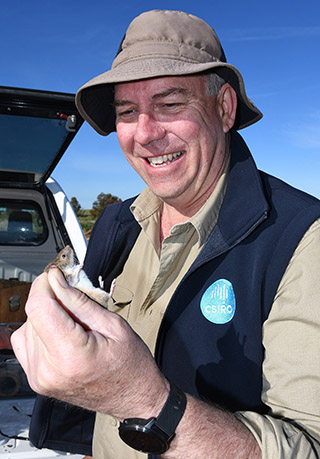Grain on the ground could trigger mouse problems at sowing
Grain on the ground could trigger mouse problems at sowing
Author: GRDC Adelaide office | Date: 21 Jan 2020

Grain growers in areas of South Australia and Victoria where strong winds knocked grain on to the ground prior to harvest are advised to exercise vigilance ahead of their 2020 crop sowing programs to minimise the potential for damage by mice.
Parts of the Victorian Wimmera and Mallee and South Australia’s Lower Eyre and Yorke Peninsulas incurred significant head loss in November 2019 when severe winds struck.
Barley crops were hardest hit, but wheat, canola and lentil crops were also affected. In some cases, growers estimate that yields were halved, and losses were up to 2.5 tonnes/hectare.
With such a large amount of grain on the ground, rodent experts supported by the Grains Research and Development Corporation (GRDC) are warning of the risk of a rapid increase in mouse populations ahead of sowing of this year’s winter crops.
Lead researcher Steve Henry from CSIRO, Australia’s national science agency, says grain left in paddocks could sustain mouse breeding and trigger higher mouse numbers which had been at relatively low levels throughout 2019.
“Not only will a large amount of grain on the ground provide mice with a ready food source, it also means there is a reduced likelihood of mice discovering bait,” says Mr Henry, whose mouse-related research is through a GRDC investment.
“If strong winds have resulted in two tonnes/hectare of grain on the ground in some areas, that equates to up around 4000 grains per square metre.
“The challenge for growers is to reduce the food load for mice.”
Mr Henry says putting sheep on stubbles and strategic cultivation (burying grain) will assist with food reduction, and he encourages growers to spray out any summer germinations.
“While an ample supply of food does not necessarily lead to an outbreak of mice, if you have high numbers of mice in the autumn, I suggest baiting six weeks out from seeding if mouse numbers are reasonably high, and then following up with another bait application off the back of the seeder if numbers are still high at sowing.”
Zinc phosphide bait must be spread according to the label rate of one kilogram per hectare.
Mr Henry says it is critical for growers to get out of their utes and walk into paddocks to obtain an accurate understanding of current conditions in terms of the amount of grain on the ground and signs of mouse activity.
“I also urge growers to report and map mouse activity – presence and absence – using MouseAlert (www.mousealert.org.au) so other growers can see what activity is being observed in their neighbourhood and via Twitter using @MouseAlert.”
The GRDC’s major mouse-related research, development and extension program is continuing to reveal new insights about mice in Australian broad acre cropping systems.
As part of the suite of GRDC investments, CSIRO researchers have been undertaking bait substrate trials to determine what is driving a perceived reduction in efficacy of zinc phosphide bait and testing potential new bait substrates that might be more attractive to mice.
Researchers are testing the willingness of mice to transition from one food to another and then determining whether mice will continue to eat that alternative food source once zinc phosphide bait has been applied.
The work being undertaken by CSIRO is outlined by Mr Henry in a GRDC podcast at http://bit.ly/2WyolPA and video at http://bit.ly/305AayV.
The next phase of the research will examine the role of available alternative food on commercial zinc phosphide bait effectiveness.
The GRDC mouse-related investments include a focus on mouse ecology. This work will involve a series of experiments aimed at understanding how mice function in zero and no-till cropping systems.
Mouse ecology research will address five key topics – farming practices, managing refuge habitat, understanding mouse movements, mouse burrows and bait delivery.
Results from bait substrate experiments, in conjunction with the results of the work in the five key mouse ecology priority areas, will form the basis of a series of recommendations for improved mouse control strategies for Australian grain growers.
A comprehensive GRDC Mouse Control resource hub is available at http://bit.ly/2ImjEEn.
Contact Details
For Interviews
Steve Henry, CSIRO
Phone 0428 633844
Contact
GRDC Adelaide office
Phone (08) 8198 8400
GRDC Project Code: CSP1806-017RTX, CSP1804-012RTX, CSP1806-015RTX,
